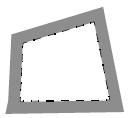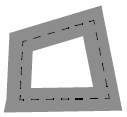 button (100).gif) Buffer
Buffer button (100).gif) Buffer
BufferAlso see:
 button (80).gif) Buffer displays the Create Buffer dialog for creating a buffer around the currently selected item(s).
Buffer displays the Create Buffer dialog for creating a buffer around the currently selected item(s).

Configuration
Distance
The buffer distance, or a space-separated list of distances, or a 'repeat' command, e.g. '10 r 5' or '20 rep 3'.
Click here for more information on coordinate systems.
To create multiple buffers at different distances, either:
- Enter a number of individual values in the Distance box, for example: entering 50 60 70 80 would create buffers at the distances of current units, i.e. 50m 60m 70m and 80m. Note: No delimiters are required only the numerical values to be entered.
- Type rep after the value in the Distance box, followed by how many times the buffer should be repeated. For example: 1000 rep 3 will create a buffer of 1000m (or current units) and repeat that 3 times.
Making either of the above types of entry will cause the Repeat (rep) command to become active.
Parameter
This is an additional parameter only available for QZone and Geodetic buffers.
QZone - the size of the smallest cell in the QZone.
Geodetic - the number of points to be used when creating the buffer.
Results
Combine
Available for Exterior and QZone buffers - Check the Combine tickbox if multiple buffers are to be combined into a single item.
Checking the Combine tickbox makes the Copy parameters invalid.
Repeat
To make Repeat active see the Distance description above.
Compound - Repeated buffer polygons incorporate previous buffer polygons.
Incremental - Repeated buffer polygons are made from a single buffer and are not an accumulation of previous buffers.
The initial buffer will remain the same no matter which option is selected.
Copy
Properties - Should the properties of the original item be copied onto the buffer polygon?
Styles - Should the styles of the original item be copied onto the buffer polygon?
The different types of advanced buffer are described below:
|
|
Creates a new Polygon that includes the original Polygon, plus a buffer around |
|
|
Creates a new Polygon that includes the original Polygon, but excludes a buffer |
|
|
Creates a new Polygon that only includes those parts of a buffer around the boundary of the original Polygon that are outside the original Polygon.  |
|
|
Creates a new Polygon that only includes those parts of a buffer around the boundary of the original Polygon that are inside the original Polygon.  |
|
|
Creates a new Polygon that only includes a buffer around the boundary of the original Polygon.  |
|
|
Creates a new Polygon on one side of the original linear item.
|
|
|
Creates a new Polygon using 'geodetic' distances from the original item. The Parameter entry in the Create Buffer dialog specifies the number
|
|
|
Creates a new QZone that includes the original item(s). The Parameter entry in the Create Buffer dialog specifies the size of
|
See also Spatial Analysis - Creating advanced buffers.
Top of page
Send comments on this topic.
Click to return to www.cadcorp.com
© Copyright 2000-2017 Computer Aided Development Corporation Limited (Cadcorp).